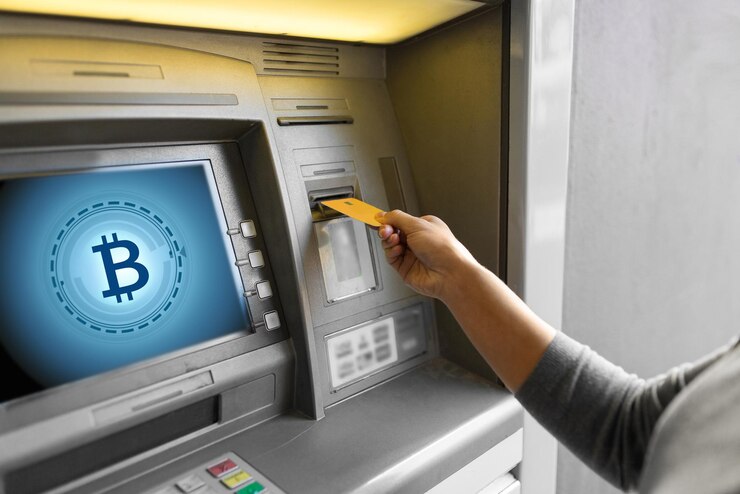Introduction and Context
Cryptocurrencies, particularly Bitcoin, have disrupted traditional financial systems worldwide. The decentralized nature of cryptocurrencies puts them beyond the control of central banks, financial institutions, and governments.
This decentralization has led to both opportunities and challenges, particularly in the realm of tax compliance and financial transparency. In Canada, the rise of Bitcoin Automated Teller Machines (ATMs) in businesses is a testament to the growing influence of cryptocurrencies on everyday transactions.
Bitcoin ATMs, which allow users to buy or sell Bitcoin using cash or debit cards, have proliferated in various parts of the world, including Canada. These machines symbolize the intersection of digital currency and traditional retail, offering a convenient way for users to engage with the cryptocurrency market. However, this convenience comes with challenges, particularly for the Canada Revenue Agency (CRA), which seeks to understand how these machines impact tax compliance and business operations.
This comprehensive analysis dives into the motivations behind the installation of Bitcoin ATMs in Canadian businesses, the perceived benefits and challenges, and the broader implications for tax compliance and financial regulation.
Historical Context and Global Perspective
Bitcoin ATMs were first introduced in 2013, and their adoption has been steadily growing. As of 2024, there are over 35,000 Bitcoin ATMs worldwide, with the United States leading in the number of installations.
Canada ranks second, with a significant number of these machines located in major cities like Toronto, Vancouver, and Montreal.
The global spread of Bitcoin ATMs reflects the increasing mainstream acceptance of cryptocurrencies.
However, the regulatory landscape varies significantly across countries. For instance, while some countries like Japan have embraced cryptocurrencies and provided clear regulatory frameworks, others like China have imposed strict regulations, limiting the growth of Bitcoin ATMs. This global context is crucial for understanding the challenges and opportunities facing Bitcoin ATM operators and businesses in Canada.
Decision Process: A Deeper Dive
The decision to install a Bitcoin ATM in a business is influenced by several factors. For many business owners, the primary motivation is the potential to increase foot traffic and, consequently, sales.
Bitcoin ATMs attract a niche market of tech-savvy customers who are interested in cryptocurrencies, and this can translate into new business opportunities.
However, the decision-making process is not without its complexities. Business owners must weigh the potential benefits against the risks, including the volatility of Bitcoin prices and the regulatory uncertainties surrounding cryptocurrencies.
Some businesses may also face ethical dilemmas, particularly if they perceive Bitcoin users as engaging in illicit activities or tax evasion.
To better understand these dynamics, we conducted in-depth interviews with 20 Canadian business owners who have installed Bitcoin ATMs in their establishments. These interviews revealed a range of motivations, from purely financial considerations to personal interest in cryptocurrencies.
Key Findings:
- Increase in Foot Traffic: The majority of business owners reported an increase in foot traffic after installing a Bitcoin ATM. However, this did not always translate into increased sales, as many users came specifically for the ATM and did not purchase other goods or services.
- Financial Compensation: Business owners were generally compensated by Bitcoin ATM operators either through a fixed monthly rent or a percentage of the transaction fees. While the fixed rent provided a steady income, the percentage model was more variable, depending on Bitcoin’s market price and ATM usage.
- Marketing and Image: For some businesses, particularly those in the technology or trendy retail sectors, having a Bitcoin ATM was seen as a marketing tool, enhancing the business's image as modern and forward-thinking.
Economic Impact: Detailed Analysis
The economic impact of Bitcoin ATMs on businesses varies significantly depending on the business type and location. For example, convenience stores and cafes located in busy urban areas with high foot traffic generally saw more frequent use of their Bitcoin ATMs compared to those in less populated regions.
Revenue Models:
- Fixed Monthly Rent: This model provided consistent revenue, with most businesses earning between $200 and $550 per month. This income was particularly valuable for small businesses with tight margins.
- Transaction Fee Percentage: This model was more lucrative during periods of high Bitcoin prices, as transaction volumes increased. However, it also exposed businesses to the volatility of the cryptocurrency market, with income fluctuating based on Bitcoin’s price.
Broader Market Trends:
- Increased Adoption: As more people become familiar with cryptocurrencies, the demand for Bitcoin ATMs is likely to increase. This trend is particularly evident among younger demographics who are more inclined to adopt new technologies.
- Regulatory Influence: The future of Bitcoin ATMs in Canada will be significantly influenced by regulatory developments. Clear guidelines from the CRA and other regulatory bodies could encourage more businesses to install Bitcoin ATMs, while stringent regulations might deter them.
Tax Compliance and Legal Issues
One of the most significant challenges facing businesses with Bitcoin ATMs is ensuring tax compliance. The decentralized and often anonymous nature of cryptocurrency transactions makes it difficult for authorities to track income and capital gains, leading to potential under-reporting or non-reporting of taxable income.
Legal Considerations:
- Tax Reporting: Business owners are required to report all income, including any received through Bitcoin ATM transactions. This includes both the fixed rent or percentage of transaction fees earned. Failure to accurately report this income can result in penalties and interest charges from the CRA.
- AML/CTF Compliance: Bitcoin ATM operators must comply with stringent Anti-Money Laundering (AML) and Counter-Terrorism Financing (CTF) regulations. This involves registering with FINTRAC, monitoring transactions, and reporting any suspicious activities. These measures are crucial for preventing the misuse of Bitcoin ATMs for illegal activities
- CSA Guidelines: The Canadian Securities Administrators (CSA) have issued specific guidelines that impact businesses dealing with cryptocurrencies. This includes strict rules for the operation of Bitcoin ATMs, especially regarding the handling of stablecoins, which may be classified as securities or derivatives
Comparative Analysis:
- United States: The U.S. has implemented stringent regulations for Bitcoin ATMs, including mandatory registration with the Financial Crimes Enforcement Network (FinCEN) and adherence to KYC and AML standards. These regulations have led to higher compliance costs but also greater legitimacy for Bitcoin ATMs.
- Japan: Japan’s regulatory approach has been more favorable, with clear guidelines for cryptocurrency exchanges and Bitcoin ATMs. This has led to increased adoption and a more robust market for Bitcoin ATMs in the country.
User Demographics and Behavioral Analysis
Bitcoin ATM users represent a diverse demographic, but certain trends are apparent. Most users are young, tech-savvy individuals, predominantly male, who are interested in cryptocurrencies either as an investment or as a medium of exchange.
Behavioral Insights:
- Investment Motives: The majority of users are driven by investment motives, purchasing Bitcoin in small amounts with the hope of profiting from future price increases.
- Transactional Use: Some users, particularly younger individuals, use Bitcoin ATMs to purchase Bitcoin for online transactions. This group is more likely to use Bitcoin as a currency rather than an investment vehicle.
- Illicit Activities: A minority of users are suspected of using Bitcoin ATMs for illicit activities, such as money laundering or tax evasion. While business owners generally lack concrete evidence, this perception highlights the need for enhanced regulatory oversight.
Victims of Scams:
Bitcoin ATMs have also become a tool for scammers, particularly those targeting elderly or vulnerable individuals.
Scams often involve fraudulent calls from individuals posing as CRA or law enforcement officers, instructing victims to deposit money into a Bitcoin ATM. Business owners reported several instances where they were able to intervene and prevent the scam, but many other cases likely go unnoticed.
Business Use of Bitcoin: A Limited but Growing Trend
While the primary focus of Bitcoin ATMs is on consumer use, some businesses have started to explore the use of Bitcoin in their operations. However, adoption remains limited due to several challenges, including price volatility, lack of regulatory clarity, and integration with existing financial systems.
Examples of Business Use:
- Employee Compensation: One business owner reported paying an employee partially in Bitcoin, which was facilitated by the Bitcoin ATM. This arrangement was made at the employee’s request and highlights the potential for cryptocurrencies in payroll management.
- Supplier Payments: Another business, operating in the technology sector, used Bitcoin to purchase supplies from vendors who accepted cryptocurrency payments. This use case is still rare but could grow as more suppliers begin to accept Bitcoin.
Barriers to Adoption:
- Volatility: The fluctuating value of Bitcoin remains the biggest barrier to its adoption as a business tool. Businesses are hesitant to hold Bitcoin due to the risk of significant losses.
- Regulatory Uncertainty: Without clear guidelines from regulators, many businesses are reluctant to incorporate Bitcoin into their operations.
- Customer Demand: While there is growing interest in Bitcoin, customer demand for Bitcoin-based transactions remains low, limiting its appeal to businesses.
Conclusion: The Future of Bitcoin ATMs in Canadian Businesses
Bitcoin ATMs represent a fascinating intersection of traditional retail and cutting-edge technology. While their adoption in Canadian businesses is still in its early stages, the potential for growth is significant. As cryptocurrencies continue to evolve, so too will the role of Bitcoin ATMs in the retail landscape.
For business owners, the decision to install a Bitcoin ATM is not without risks, but the potential rewards—both financial and reputational—make it an option worth considering. However, businesses must navigate a complex regulatory environment and be prepared for the challenges that come with adopting new technologies.
For regulators, the rise of Bitcoin ATMs presents both opportunities and challenges. On the one hand, these machines can facilitate greater technologies and promote financial inclusion. On the other hand, they pose significant risks in terms of tax compliance and financial crime. A balanced regulatory approach that encourages innovation while protecting consumers and the financial system is essential for the future of Bitcoin ATMs in Canada
If you have any questions or require further assistance, our team of accountants at Tax Partners can help you.
Please contact us by email at info@taxpartners.ca or by phone at (905) 836-8755 for a FREE initial consultation appointment.
You may also visit our website (www.taxpartners.ca) to learn more about other services we offer in Canada, US and abroad.


